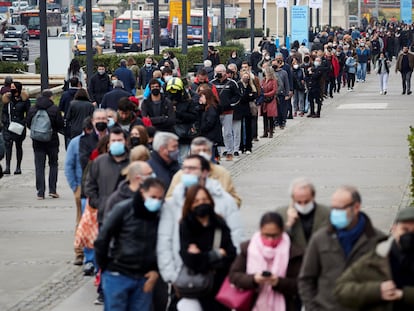US life expectancy drops for second straight year, driven by Covid
The pandemic is chiefly to blame for the decline from 77.0 years in 2020 to 76.1 years in 2021, the largest two-year reduction in nearly a century. Native American and Alaska Native communities have been especially hard hit


The life expectancy curves of a country tell the story of its own history. In the United States, the 1918 so-called Spanish flu, the Great Depression and World War II all left their mark. Now, the Covid pandemic leaves a new notch for history. Life expectancy at birth fell again in 2021 for the second consecutive year, down to 76.1 years from 77 years in 2020 and 78.8 years in 2019, according to provisional data released on Wednesday by public health authorities.
In the first two years of the pandemic, the decline was 2.7 years, the sharpest two-year drop since the 1920s, when average expectancy fell to 57.2 in 1923 from 60.8 in 1921. The one-year drop from 2019 to 2020, from 78.8 years to 77 years, already represented the biggest one-year decline since World War II.
Life expectancy at birth measures how many more years on average newborns can expect to live if the patterns of mortality in a given year are maintained for the rest of their lives. The drop to 76.1 years leaves life expectancy at the lowest level since 1996, according to the Centers for Disease Control and Prevention’s National Center for Health Statistics. Men’s life expectancy has fallen to 73.2 years and women’s to 79.1 years, a six-year difference between the sexes that is also the largest since 1996.
The pandemic, which has left more than a million dead in the United States, more than in any other country in the world, has not hurt everyone equally. Native American and Alaska Native communities have been hit especially hard. Life expectancy fell to 65.2 among Native Americans and Alaska Natives, the same as all Americans in 1944.
Life expectancy loss has also been greater among Hispanics (4.2 years since 2019) and African Americans (four years since 2019) than among non-Hispanic whites (2.4 years) and Asians (2.1 years). The excess of deaths in these two years of the pandemic has reduced the life expectancy of men (3.1 years) more than that of women (2.3 years).
The decrease in life expectancy is the balance between the increase in mortality from specific causes and the decrease in others. Obviously, Covid has been the main cause of the decline, with half of the deaths, followed at a great distance by accidents and drug overdoses (grouped under the chapter of unintentional injuries), heart attacks and suicides. In addition to its direct effect, it is more difficult to measure how Covid has indirectly affected the treatment of other diseases due to the saturation of health services.
On the other hand, mortality from the common flu and pneumonia and respiratory diseases not associated with Covid has decreased, surely due to prevention measures such as the use of masks or social distancing, which helped prevent other diseases. Mortality due to Parkinson’s and Alzheimer’s and deaths derived from complications in the health of newborns also decreased.
The sharp drop in life expectancy for two consecutive years further distances the United States from other Western countries. Chronic health coverage problems, obesity and relatively high homicide rates place the country far from the levels of Canada, Australia, Japan and the most developed European countries, where life expectancy is above 80 years. The life expectancy of the United States is now at levels similar to those of 2019 (before the pandemic) in countries such as Morocco, Algeria, China or a good part of the countries of South America.
The data published by the National Center for Health Statistics are early estimates based on death certificates received, processed and recorded, but they are not definitive. Death certificate information may be reviewed, and additional death certificates may be received up to approximately six months after the end of the year. But variations in the definitive data do not usually make a significant difference in the main aggregates.
Tu suscripción se está usando en otro dispositivo
¿Quieres añadir otro usuario a tu suscripción?
Si continúas leyendo en este dispositivo, no se podrá leer en el otro.
FlechaTu suscripción se está usando en otro dispositivo y solo puedes acceder a EL PAÍS desde un dispositivo a la vez.
Si quieres compartir tu cuenta, cambia tu suscripción a la modalidad Premium, así podrás añadir otro usuario. Cada uno accederá con su propia cuenta de email, lo que os permitirá personalizar vuestra experiencia en EL PAÍS.
¿Tienes una suscripción de empresa? Accede aquí para contratar más cuentas.
En el caso de no saber quién está usando tu cuenta, te recomendamos cambiar tu contraseña aquí.
Si decides continuar compartiendo tu cuenta, este mensaje se mostrará en tu dispositivo y en el de la otra persona que está usando tu cuenta de forma indefinida, afectando a tu experiencia de lectura. Puedes consultar aquí los términos y condiciones de la suscripción digital.










































